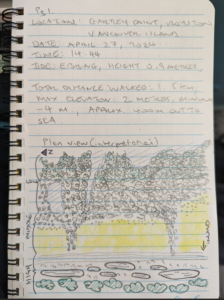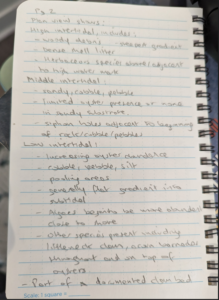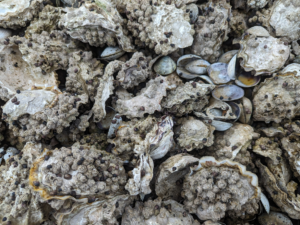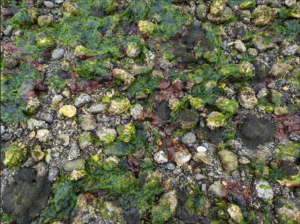The organism which I plan on studying is the Pacific oyster (Crassostrea gigas).
I examined one environmental gradient at the time of my list field visit (April 27, 2024) to assist in development of my hypothesis. This gradient included the low, middle and high intertidal zone.
Crassostrea gigas, amongst evidence of other epifauna and infauna, were observed as most abundant and larger in the low intertidal zone. Particularly dense aggregations of oysters generally seemed to share space with other bivalve shell debris, e.g. Pacific littleneck clams (Leukoma staminea), and the oysters also appeared to be covered in acorn barnacles (Balanomorpha). Substrate within this zone included cobbles, gravels and silts and a higher abundance of algae species e.g. sea lettuce (Ulva lactuca). Evidence of recent tidal inundation was apparent in this zone, with pooling areas and general moistness present here. Oysters appeared to be the most dominant bivalve species within the low intertidal zone.
Distribution of Crassostrea gigas within the middle intertidal zone became a little more random and less dense. Colouration of oysters were more apparent here as they were not covered in as much algae or barnacles; they varied between grey, white, blue and purple and appeared to be smaller than oysters viewed in the low intertidal. Substrates within the middle intertidal included cobbles, gravel, silt and sand. Sands closest to and/or potentially within the high intertidal zone were water saturated underfoot with siphon holes growing in abundance directly next to cobble and gravel substrate. Water saturation within the sand decreased with increasing distance inland. Crassostrea gigas were not present in the sandy patches within the middle to high intertidal zone. The high intertidal zone marked another change in substrate with woody debris, grassy detritus, and crustacean moults present in this location. There were layers of bleached Crassostrea gigas shells in this location. See field journal and photos for more information.
Subject to my two visits to the Site and observations made, I propose the following hypothesis and prediction.
Hypothesis: If a symbiotic relationship between Pacific oysters (Crassotrea gigas) and other epifauna and infauna exists, species abundance and diversity will increase alongside increased abundance and diversity of Pacific oysters.
Prediction: The presence of Pacific oyster will increase overall epifauna and infauna abundance and diversity within the low intertidal zone.
My potential response and explanatory variables are as follows.
Response variable: Relative abundance and diversity of epifauna and infauna (excluding Pacific oyster, continuous).
Explanatory variable: Relative abundance and diversity of Pacific oyster (continuous).








I’m not sure you can say that the increased diversity of other species has to do with pacific oyster? What is your rationale for that? To determine if this is the case you would need to rule out any other possibilities. I would suggest you change your hypothesis to changes along the intertidal zone in general. With substrate changes and water level changes and possibly other changes along the gradient it will be hard to show with a natural experiment what is causing those changes. You could measure substrate changes and note that could be one potential factor.
Thank you for the feedback, and that makes sense – there’s a lot of other processes at play in the area that could influence. So, a more suitable hypothesis could be “epifauna abundance and diversity increases as substrate changes within the intertidal zone?”
I think your study comparisons in substrate changes affecting epifauna abundance in the intertidal zone suit the more general hypothesis that you stated. I have kind of a similar issue with my study starting out, where I had to stratify my sample populations and simplify my response variable to be comparable across the different categories.
I agree that there are so many processes at play that can influence the results, so it is hard to define the variables So much complexity is what makes the ecology so fascinating I guess!